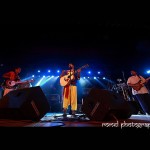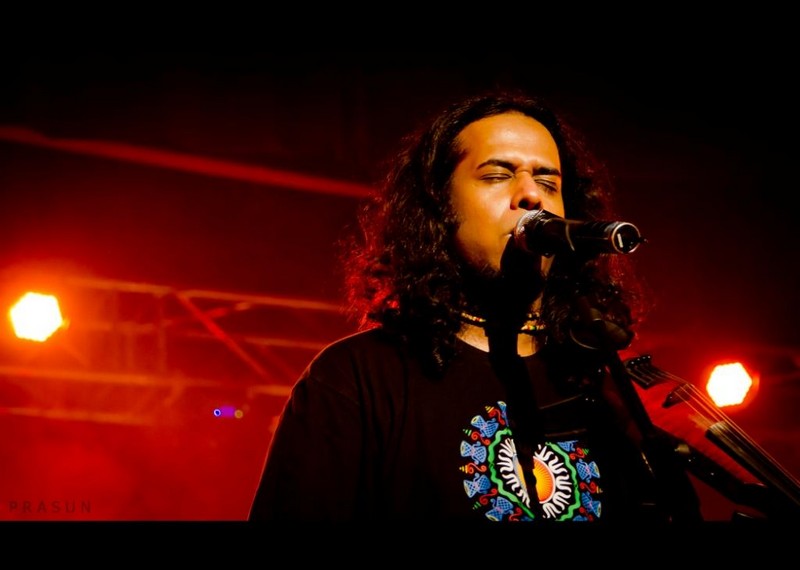
I did not know much about Vibha.org, a charitable organization founded in 1991, when I entered the St. John’s Auditorium on Saturday. By the end of the evening, however, I developed great respect and admiration for the work they do. The event was called Vibha Dhwani where bands that strongly personify Indian culture – The Raghu Dixit Project (TRDP), Agam and La Pongal were invited to perform.
Until Saturday afternoon, I was to watch TRDP, Agam and Yodhakaa play; however, due to slight confusion, as it was put, La Pongal, a Tamil folk rock band, replaced Yodhakaa in the line-up. The band which contained two key members from Yodhakaa was in the middle of their sound check when I entered the disinfectant-smelling auditorium. The stage setting had a nice rustic touch to it, with kites and hay, certain to remind you about the fun times that you had as a kid back in your village. Considering how the whole evening eventually panned out, the stage design intent was spot-on. About an hour to go before the start of the event and Agam, except one member, was nowhere to be seen. Not really a bad thing, as I’ve known Agam to do their sound checks a day before the event, something they did at the Big Junction Jam back in June.
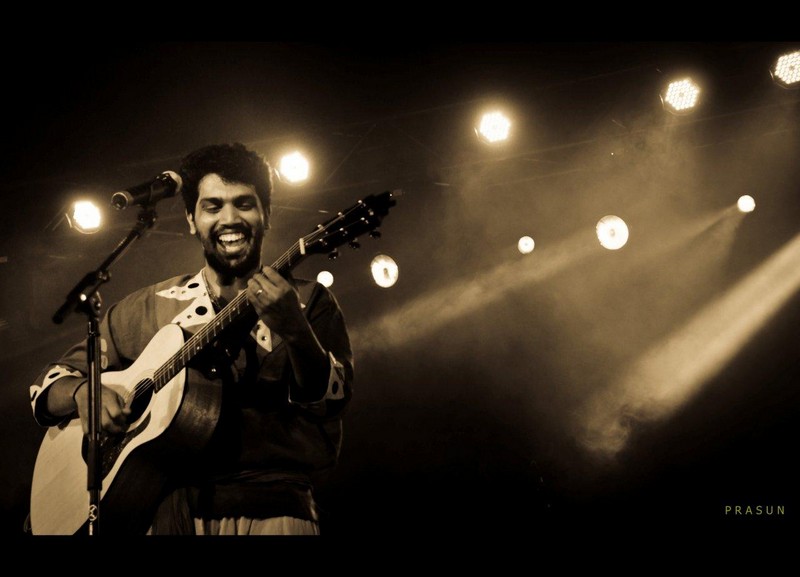
I had met Darbuka Siva backstage for a short interview. He talked about taking Tamil culture wherever he went, the importance of attire to a performance and musicians as entertainers. A while later, I was in the middle of my interview with the man who symbolizes the beginning of folk rock in modern India, Raghu Dixit backstage when La Pongal started their act. BANG on time! I took a seat in the front row as La Pongal dived into their second song ‘Killiamma‘. Pradeep on the vox and acoustic guitar and Darbuka Siva on the bass co-fronted the band. Pradeep who has a background in Carnatic is a real joy to listen to and was easily La Pongal’s stand-out performer that evening. In my book, he’s got the right voice timbre to become indispensable to La Pongal’s overall sound. The first few songs had a similar structure about them – an acoustic guitar start, bass-drums-tavil joining in and the lead guitarist Vikram providing the fills, a mellow interlude and a crescendo finish. I must also credit Pankajan on the tavil because the folksy touch of La Pongal would have been non-existent if it weren’t for him. David on the drums was having an absolute ball if the sound on the PA was similar to what he heard on his monitors. I assumed that it was, considering he executed a crisp drum solo (and by the looks of it, enjoyed it too) before La Pongal went onto their next song, ‘Vandiyilla Nella Varum’.
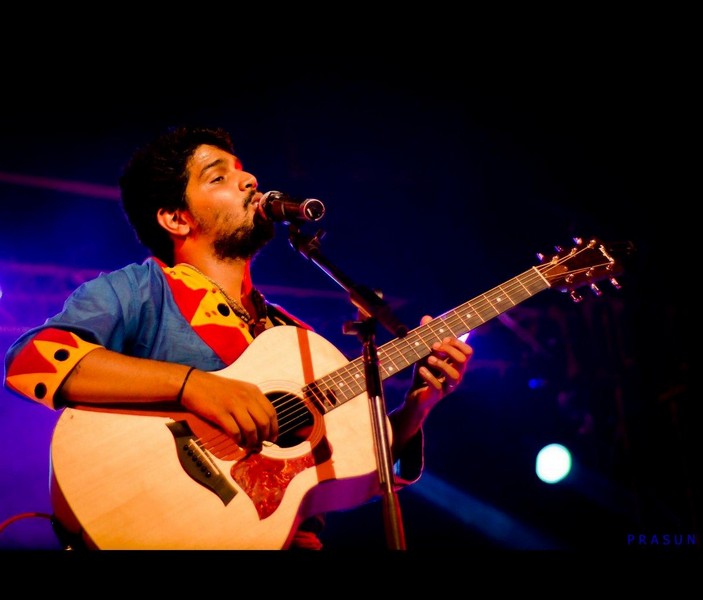
Later, La Pongal broke their song pattern to play a song derived from a Tamil folk standard known as ‘Kuravan Kurathi Aatam‘ which was relatively less hard-hitting and mellower. Thumbs up to this one! Pradeep improvised with a guitar solo of his own. At this point of time, I had noticed that the lighting of the stage was also neatly done as it reflected the soft nature of the song. One of their last songs which Siva said was borrowed from a kid’s game, had a nice reggae feel to it. The little inputs to the song were so apt that it did seem like children playing in the background!
Overall, La Pongal still showed signs of starting off as they suffered issues in tightness in some songs. However, of the three bands they had the most rustic sound and I daresay that, with songs like the aforementioned, they were the closest to the theme of the whole event.
After La Pongal made their exit from the stage, Vibha showcased their work through a short movie. I was impressed with some of their innovative concepts like School on Wheels. There were actual clips from how teachers teach the students, a few short classes in Marathi and interviews with the children’s parents. Having their children educated and display the confidence that it brings in their daily life activities put a genuine smile on their faces. Ten minutes after the movie, Agam were ready with their act.
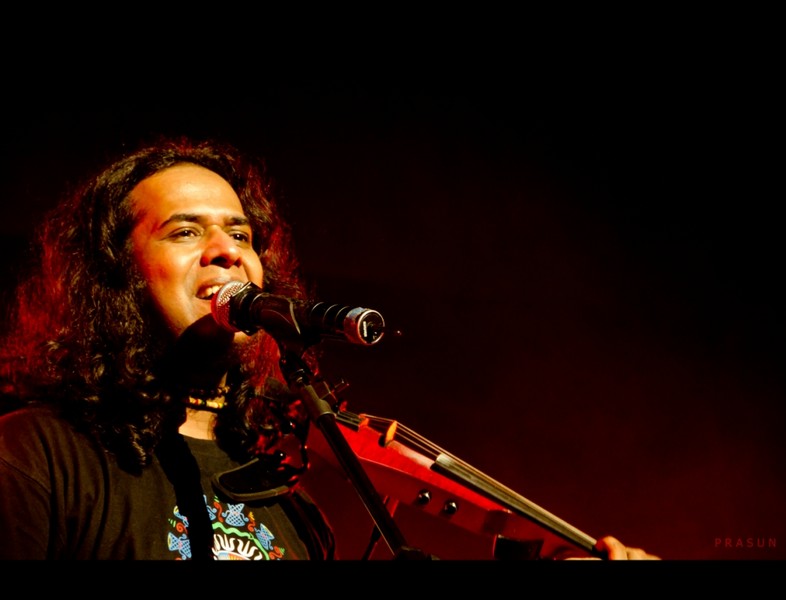
Before you notice any likely bias from this point on, I must warn you that I’m a huge fan of Harish, the frontman of Agam. Trained in Carnatic, he was on that day, confident and charismatic. He does give the impression of being in a hurry though. But coming to the whole band, Agam were really tight, demonstrating great communication, sync and not to mention, loads of practice! They started off with ‘Brahma’s Dance’, a song in the raga Revathi and which incorporated the well-known ‘Guru Brahma, Guru Vishnu‘ shloka. Harish’s voice modulations and Vignesh’s slap bass were memorable from that song. They followed it up with a thillana in Raga Dhanashri. This is the same thillana, composed by Sri Swathi Thirunal and made popular by the evergreen voice of M.S Subbulakshmi. Pity not many realize how dry our culture would be if it weren’t for them, but I’m glad that the people took note of Agam’s extraordinary rendition.
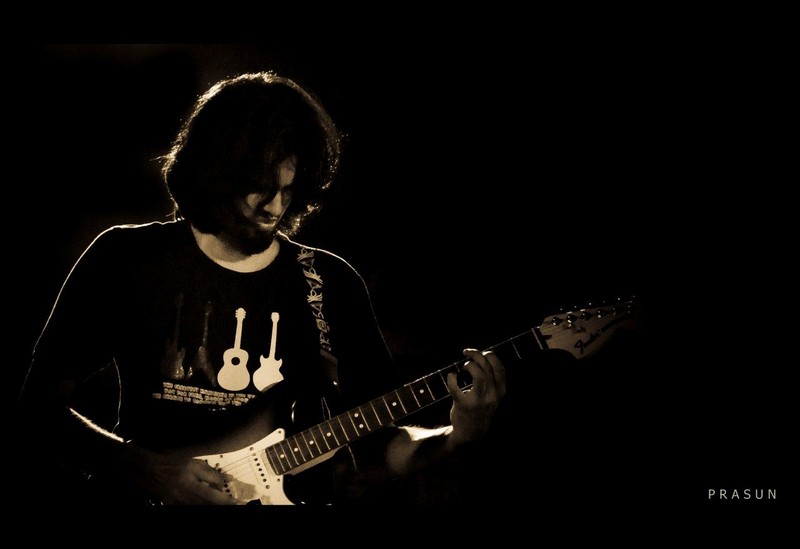
Agam then launched into song they were performing live for the first time, a song in Malayalam called ‘The Boat Song’. Praveen, the lead guitarist, was at the center of this piece with some real good work on the guitar. The song was catchy and you should be able to hear more of it in the future. Agam went on to perform a song in the raga Nattai before launching onto an Urdu number called ‘Muqammal’. It seemed to bear a stark resemblance to the kind of songs A.R Rahman would compose. The song had a jazzy opening, with Agam breaking free from their hard-hitting openings and Harish alaaped in raga Ahirr Bhairav. Strangely though, following a dholak interlude the song threatened to end as ‘Lagan Lagi’ from the movie Tere Naam, but thankfully, the band ended it as the original piece should. I noticed a slight echo in Harish’s vocals, hopefully intentional, in their next song, ‘Bandurithi Kolu‘, a Thyagaraja Swamigal composition in the raga Hamsanadham. The song was interspersed with complicated proggy stuff and a good show of tightness and Harish’s vocals backed up by Vignesh’s were brilliant along with some accidentals in the overall song! Here, I could be a cynic and disregard the progressive stuff that a non-elite crowd seldom relates to, but I’m as happy as a frog in the rain that a rock band played Thyagaraja! More of that please!
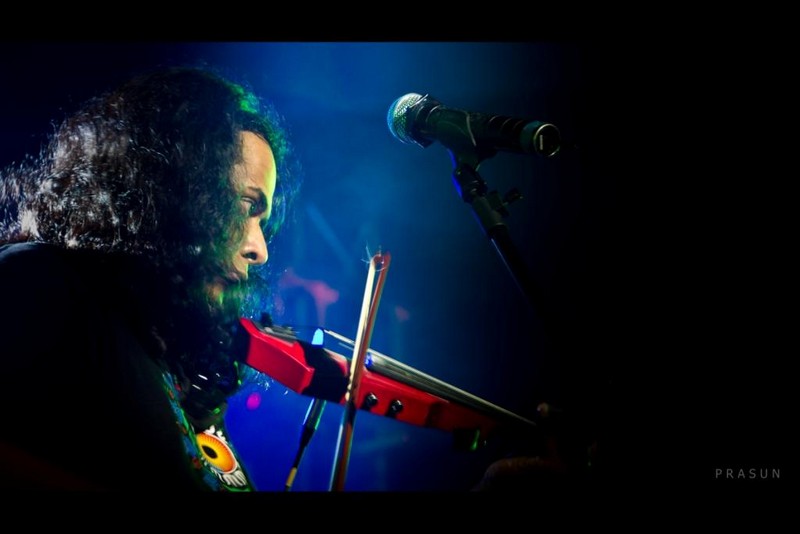
And how can an Agam gig be complete without their ace song, ‘Rudra‘? Their second Revathi song of the evening, ‘Rudra‘ was a mind-blowing hit and it won over the crowd. At a point, it seemed that Harish overdid his vocal roller coaster, but it was a definitive display of skill, energy and stamina. To be at the end of a 90-minute show and still be able to stretch your voice better than minute one deserves applause. Their last song, ‘Malhar Jam‘, was where the crowd was able to recognize the prowess of Ganesh on the drums and Shiva on the percussions who indulged in a jugalbandi with various sounds that people instantly related to and enjoyed. Swami on the keys and Suraj on the rhythm guitar did not appear to take a central role, but I’m certain that without them, Agam’s sound wouldn’t be what it was that evening. Overall, I am overjoyed that a carnatic rock band exists, but a greedy person like me wants more. I would love it if they render more Carnatic compositions in a less hard-hitting style and experiment with other styles of rock. And before I forget to mention, they received a 20-second standing ovation as the curtains closed on an exhilarating performance!
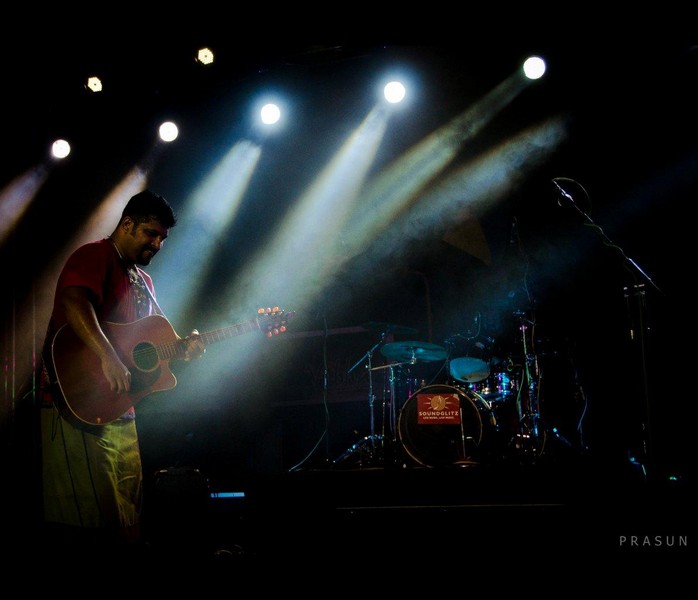
If La Pongal received a huge applause and Agam received a standing ovation, then The Raghu Dixit Project went one level further. I’m not sure if people sat at all during his act! I especially loved the lighting during his opening song ‘Hey Bhagwaan’ wherein, we could only see silhouettes! When the song started, there was a deafening roar of approval from the crowd. Maybe it was the moment, but I did feel TRDP were the tightest of the lot. There was a surprise addition to the line-up as Slain’s lead guitarist Bryden Stephen Lewis joined the crew in his debut lungi attire. Sandeep on the flute was mesmerizing, his sound complemented the band perfectly and his solos were out of this world! He would occasionally step up to the podium where Wilfred played the drums and engage in a sort of a telepathic conversation while playing. TRDP kicked on with the Kannada number ‘Gudugudiya‘. Occasionally, Raghu would march with his ghungroos giving the songs an extra dimension. Then finally, TRDP became the first band of the evening, to engage the crowd in their song as everyone yelled out the lyrics to ‘Lokat Kalaji‘, Raghu adding his humourous touch to the explanation of the song’s meaning. Just off the stage, a crowd had gathered and they jumped and danced with gay abandon, while the crowd from the balcony seats gathered and stood in the tier below.
As happy I was when Agam played Swathi Thirunal and Thyagaraja, I was happy when TRDP played songs by Sant Shishunala Sharif, whose poems are widely compared to those of Kabir. Kids in Karnataka learn his poems in school and it was a trip down memory lane for the arguably not-so-many in the cosmopolitan crowd. Coming back to the band, Gaurav Vaz on the bass was impressive with some licks to keep the crowd grooving while Bryden’s solos were jazzy and he made it look absolutely effortless. As a frontman, you really have to admire Raghu. There’s a lot upcoming musicians can learn about carrying themselves confidently on stage.
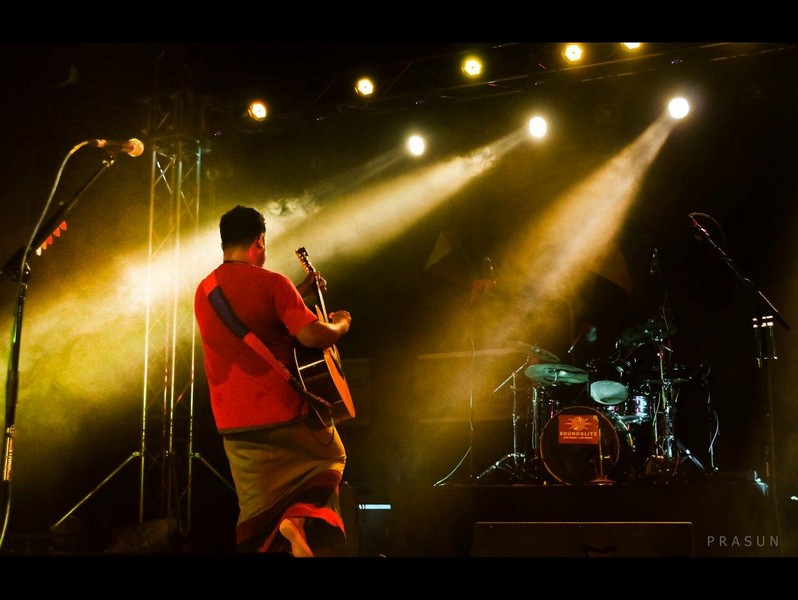
TRDP went on to their next song, ‘Sajna‘, a softer number composed by Neeraj Singh in the 7/4 time signature (or Mishra Chapu for carnatic enthusiasts). This song was arguably TRDP’s standout piece of the whole act. People who came to dance near the front of the stage did not mind one bit to camp on the floor, soaking in the soft tunes of ‘Sajna‘. The crowd didn’t have to wait long to start dancing again and singing along to ‘Har Saans mein, Har Dhadkan mein ho Tum’ a song from Raghu Dixit’s work for a movie that is based on Facebook. Raghu cleverly started off with a hilarious jig of Sting’s stalker anthem ‘Every Breath you take’ before beginning the song. I thought it was impossible to accommodate more people near the now-crowded stage front, but I was proved wrong when more people joined in to dance to ‘Mysore se aayi Woh’ where Gaurav Vaz taught the crowd the never-before-heard dance steps of ‘put your hands together’ and ‘jump’. The band then did their trademark group bow before the crowd yelled out for more. And TRDP duly obliged with a last Kannada number before departing the stage. Overall, TRDP demonstrated great skill, sync along with trashing my baseless assumption that folk rock bands are a one-time watch. It would be fair to say that TRDP’s music is the music of the people and it brings out the child in you.
As an event, Vibha Dhwani did not disappoint, not one bit! In fact, those at the show were treated to a great display of music and entertainment! More importantly, the bands that performed, accentuated the message Vibha intended to spread. The event was a good thing to happen to society for more reasons than ten!
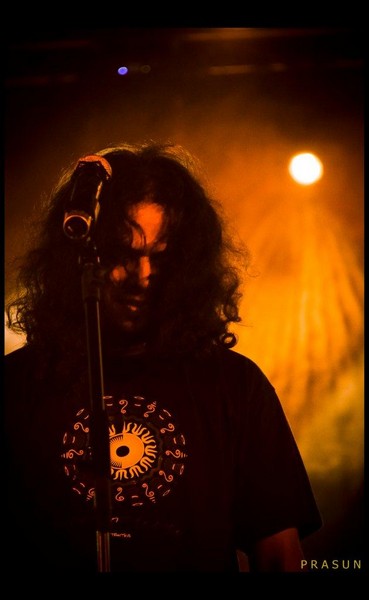 Romel DuttaRomel DuttaRomel DuttaRomel DuttaRomel DuttaRomel DuttaRomel DuttaRomel DuttaRomel DuttaRomel DuttaRomel DuttaRomel DuttaRomel DuttaRomel DuttaRomel DuttaRomel DuttaRomel DuttaRomel DuttaRomel DuttaRomel DuttaRomel DuttaRomel DuttaRomel DuttaRomel DuttaRomel DuttaRomel DuttaRomel DuttaRomel DuttaRomel DuttaRomel DuttaRomel DuttaRomel DuttaRomel DuttaRomel DuttaRomel DuttaRomel DuttaRomel DuttaRomel DuttaRomel DuttaRomel Dutta
Romel DuttaRomel DuttaRomel DuttaRomel DuttaRomel DuttaRomel DuttaRomel DuttaRomel DuttaRomel DuttaRomel DuttaRomel DuttaRomel DuttaRomel DuttaRomel DuttaRomel DuttaRomel DuttaRomel DuttaRomel DuttaRomel DuttaRomel DuttaRomel DuttaRomel DuttaRomel DuttaRomel DuttaRomel DuttaRomel DuttaRomel DuttaRomel DuttaRomel DuttaRomel DuttaRomel DuttaRomel DuttaRomel DuttaRomel DuttaRomel DuttaRomel DuttaRomel DuttaRomel DuttaRomel DuttaRomel Dutta
 Romel DuttaRomel DuttaRomel DuttaRomel DuttaRomel DuttaRomel DuttaRomel DuttaRomel DuttaRomel DuttaRomel DuttaRomel DuttaRomel DuttaRomel DuttaRomel DuttaRomel DuttaRomel DuttaRomel DuttaRomel DuttaRomel DuttaRomel DuttaRomel DuttaRomel DuttaRomel DuttaRomel DuttaRomel DuttaRomel DuttaRomel DuttaRomel DuttaRomel DuttaRomel DuttaRomel DuttaRomel DuttaRomel DuttaRomel DuttaRomel DuttaRomel DuttaRomel DuttaRomel DuttaRomel DuttaRomel Dutta
Romel DuttaRomel DuttaRomel DuttaRomel DuttaRomel DuttaRomel DuttaRomel DuttaRomel DuttaRomel DuttaRomel DuttaRomel DuttaRomel DuttaRomel DuttaRomel DuttaRomel DuttaRomel DuttaRomel DuttaRomel DuttaRomel DuttaRomel DuttaRomel DuttaRomel DuttaRomel DuttaRomel DuttaRomel DuttaRomel DuttaRomel DuttaRomel DuttaRomel DuttaRomel DuttaRomel DuttaRomel DuttaRomel DuttaRomel DuttaRomel DuttaRomel DuttaRomel DuttaRomel DuttaRomel DuttaRomel Dutta




























